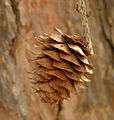Larix kaempferi
| Japanese larch | |
|---|---|
| | |
| Bark and leaves | |
| Scientific classification | |
| Kingdom: | Plantae |
| Division: | Pinophyta |
| Class: | Pinopsida |
| Order: | Pinales |
| Family: | Pinaceae |
| Genus: | Larix |
| Species: | L. kaempferi |
| Binomial name | |
| Larix kaempferi (Lamb.) Carr. | |
Larix kaempferi, known as Japanese larch[1] or karamatsu (唐松) in Japanese) is a species of larch native to Japan, in the mountains of Chūbu and Kantō regions in central Honshū.[2]
It is a medium-sized to large deciduous coniferous tree reaching 20–40 m tall, with a trunk up to 1 m diameter. The crown is broad conic; both the main branches and the side branches are level, the side branches only rarely drooping. The shoots are dimorphic, with growth divided into long shoots (typically 10–50 cm long) and bearing several buds, and short shoots only 1–2 mm long with only a single bud. The leaves are needle-like, light glaucous green, 2–5 cm long; they turn bright yellow to orange before they fall in the autumn, leaving the pinkish-brown shoots bare until the next spring.[2]
The cones are erect, ovoid-conic and 2–3.5 cm long, with 30–50 reflexed seed scales; they are green when immature, turning brown and opening to release the seeds when mature, 4–6 months after pollination. The old cones commonly remain on the tree for many years, turning dull grey-black.[2]
It grows at altitudes up to 2,900 m on well-drained soils, avoiding waterlogged ground.
The scientific name honours Engelbert Kaempfer. It is also sometimes known by the synonym Larix leptolepis.[3]
Uses
Japanese larch is an important tree in forestry plantations, being grown throughout central and northern Japan (north to Hokkaidō), and also widely in northern Europe, particularly Ireland and Britain. The wood is tough and durable, used for general construction work. Small larch poles are widely used for fencing.
Cultivation
L. kaempferi is used for ornamental purposes in parks and gardens.[4] It is also widely used as material for bonsai.[5]
Diseases
In late 2009 the Phytophthora ramorum or sudden oak death disease was first found in Japanese larch trees, in the English counties of Devon, Cornwall and Somerset.[6]
Gallery
 Branches
Branches Male (pollen) cones (top two), immature female (seed) cone (below)
Male (pollen) cones (top two), immature female (seed) cone (below) Dried cone
Dried cone Old cone and young needles growing out of a branch
Old cone and young needles growing out of a branch Bark on the tree's trunk
Bark on the tree's trunk cones and seeds - museum specimen
cones and seeds - museum specimen
References
- ↑ "BSBI List 2007". Botanical Society of Britain and Ireland. Archived from the original (xls) on 2015-02-25. Retrieved 2014-10-17.
- 1 2 3 Farjon, A. (1990). Pinaceae. Drawings and Descriptions of the Genera. Koeltz Scientific Books ISBN 3-87429-298-3.
- ↑ "The Plant List - species in Larix". London: Royal Botanic Gardens, Kew. 2013.
- ↑ "Larix kaempferi". Royal Horticultural Society. Retrieved 23 July 2013.
- ↑ D'Cruz, Mark. "Ma-Ke Bonsai Care Guide for Larix kaempferi". Ma-Ke Bonsai. Retrieved 2011-04-18.
- ↑ Forestry Commission webpage on Phytophthora ramorum
External links
- Conifer Specialist Group (1998). "Larix kaempferi". IUCN Red List of Threatened Species. Version 2006. International Union for Conservation of Nature. Retrieved 12 May 2006.
- Gymnosperm Database: Larix kaempferi
